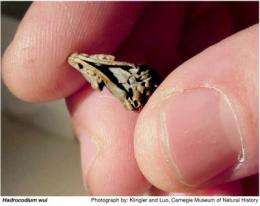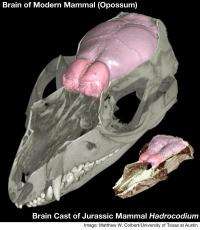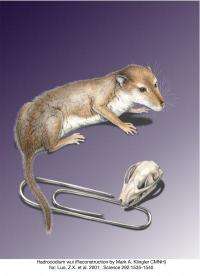Large brains in mammals first evolved for better sense of smell

Paleontologists have often wondered why mammals—including humans—evolved to have larger brains than other animals. A team of paleontologists now believe that large brains may have developed in mammals to facilitate an acute sense of smell, according to a new paper published today in the prestigious journal Science. The team also noticed enlargement in the areas of the brain that correspond to the ability to sense touch through fur; this sense is acutely developed in mammals.
Scientists used high-resolution CT scans to study rare 190-million-year-old fossil skulls of Morganucodon and Hadrocodium, two of the earliest known mammal species. The research team of Timothy Rowe (University of Texas at Austin), Thomas Macrini (St. Mary's University of Texas), and Zhe-Xi Luo (Carnegie Museum of Natural History) discovered that these tiny mammals from the Jurassic fossil beds of China had much larger brains than expected for specimens of their period. Carnegie paleontologist Luo and his colleagues were the first to discover Hadrocodium, a tiny early Jurassic age mammal that weighed just two grams. Luo noticed that this animal had a very large cranium compared to its tiny body mass, and named it accordingly ("Hadro" being Latin for "fullness"; codium for "head").

"Our new study shows clearly that the olfactory part of the brain and the part of the brain linked to tactile sensation through fur were enlarged in these early mammals," says Luo. "A sophisticated sense of smell and touch would have been crucial for mammals to survive and even thrive in the earliest part of our evolutionary history."
Using computed tomography, also known as CT scanning, the team took a series of X-rays, inching along the specimens and then reassembling the images into a single, detailed image of the interior anatomy of the fossils.
"I have spent years studying these fossils, but until they were CT scanned it was impossible to see the internal details unless you were willing to destroy the skulls to look inside," says Luo. "I was absolutely thrilled to see the shape of the brain of our 190-million-year-old relatives."
"This is a great example of technology allowing us to examine classic scientific questions in a new way," says University of Texas at Austin paleontologist Rowe. "We had studied the outside features of these fossils for years but knew that the inside held the answers. Until now, getting to those answers required destructive methods. With high-resolution CT scanning, we can take a good look into the braincase without damaging the precious fossils—we can have our cake and eat it too."
Thomas Macrini of St. Mary's University (Texas), an expert in analyzing interior structures of fossils through CT scanning, was able to construct a virtual cast of the brains of these mammals. These were compared to the team's CT-scan data from more than a dozen other fossils and some 200 mammal species living today. The results were surprising: Even 190 million years ago, the brains of the earliest mammals were notably large (as relative to body mass), with brain-to-body sizes approaching the proportions seen in modern mammals.

From previously discovered fossil evidence, scientists knew that the nasal structure in some early mammals was quite advanced. From the CT scans of Morganucodon and Hadrocodium researchers were able to determine that area of the brain that had grown the largest in these early mammals was the region responsible for the sense of smell. The CT scans of Morganucodon and Hadrocodium also revealed that the area of the brain mapped to tactile sensations from fur was enlarged. Mammals have a uniquely well developed ability to sense touch through their fur. Jurassic mammals such as Hadrocodium are considered by scientists to have had full coats of dense hair.
"Our mammal ancestors didn't develop that larger brain for contemplation, but for the sense of smell and touch. But thanks to these evolutionary advancements, which gave mammals a head start toward developing a large brain, humans some 190 million years later can ponder these very questions of natural history and evolution," said Luo.
Provided by Carnegie Museum of Natural History





















